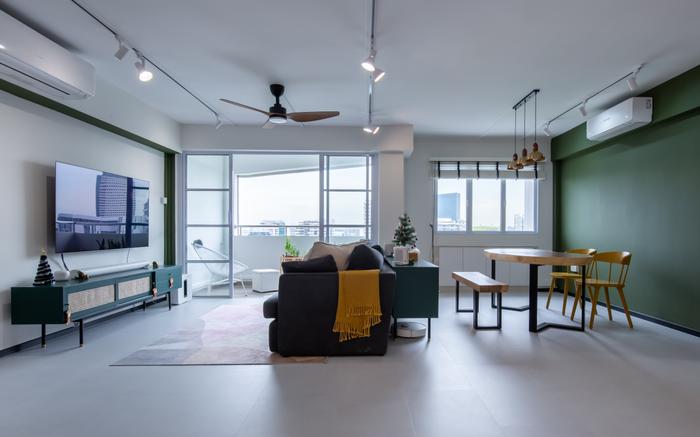Your guide to fixing (preventing) tiling problems at home.
Tiles have become one of the most popular wall and flooring finish options in modern homes. They’re effortless to clean, extremely durable and come in a multitude of eye-catching shapes, patterns and designs that are sure to make a statement under your feet. What most people don’t foresee, are the tiling problems that may start to appear through the cracks.

View this project by Ataz Haus Interior Design
Cracked and popping tiles are just some of the common issues that homeowners face when it comes to tiling applications, which usually stem from the improper choice of tile adhesives used. Using the right and proper adhesives will ensure that you create a beautiful and durable finish that lasts for a lifetime.
Here are the solutions from Weber-E.MIX (Saint-Gobain) to solve (and prevent) common tiling problems!
1. Loosened/Debonded Tiles

Ever noticed a hollow, drummy sound when walking across your floors? Doesn’t feel quite right, does it? Well, this can be an indication that your tiles have debonded after installation – which is something that should NOT happen!
One of the common reasons is due to the incorrect tile adhesive or tile grout being used, which can cause your tiles to crumble and loosen overtime. If you’re not sure what's right for you, here’s a handy guide courtesy of material experts Weber-E.MIX to help you out!

Another pro tip? When applying grout, it’s important to make sure that you mix it to the proper grout consistency and work it tightly into the joint lines so you won’t leave any gaps for water to seep in. One cool fact about Weber-E.MIX products is that they all come in a pre-packed form so you’re guaranteed to get a quality-controlled mix.

For best results, we recommend using either cementitious or epoxy-based tile grouts like the E.MIX Tile Grout and Weberepox Easy. It’s incredibly easy to apply, clean and maintain – all you have to do is add water and mix it up!
2. Cracked Tiles
Tiles can handle some pretty rough wear and tear, but that doesn’t mean they are indestructible. Sometimes, even the most well-fitted tiles are susceptible to cracks if they are hastily installed with an improper application method known as spot tiling, whereby you apply the adhesive only on the corners of each tile. This leaves voids under the tile, which results in that dreaded hollowness in areas where there’s no adhesive.

In this case, a notched trowel will come in very handy – it’s essentially a tool designed to spread and level out the adhesive to achieve complete mortar coverage. Using the trowel, simply “butter” the coating to the back of the tile and floor/wall substrate before laying the tile on an even floor/wall surface. This increases the bonding strength and allows your tiles to stay adhered in place without ever budging.
You don’t have to hack or remove the existing tiles entirely if changing of the existing tiling works. The great thing about tile adhesives is that it can be applied directly onto the existing floor tiles to repair any minor blemishes. Just make sure there’s no hollowness in the existing tiled floor before doing so!
3. Popping of tiles

A common occurrence in older HDB flats, tiles popping up might pose a safety hazard for occupants if not immediately addressed. Besides weather changes and poor workmanship, another possible reason is that there’s insufficient space between the tiles for expand expansion and contraction.
As a rule of thumb, it’s always better to allow for a joint width or gap between the tiles – a minimum of 2mm is a good gauge. Or if you prefer a more seamless solution, go for an epoxy floor instead!

View this project by Tab Gallery
For greater flexibility, the E.MIX Tile Fix 383 will make your job much easier. It’s capable of withstanding weather conditions and able to cater for the expansion and contraction of tiles. Did we mention it’s water-resistant too?
4. Stained Tiles

Between the spills, splashes and messes of everyday life – especially in high-traffic areas such as kitchens and bathrooms – it’s basically impossible to keep your tiles spotless at all times. This happens more often on natural stone tiles such as marble, limestone or travertine, which tend to be porous and are more prone to staining.

For lighter coloured tiles and grout, an easy fix is to use white tile adhesives so stains are less noticeable. Weber-E.MIX’s Tile Fix 303, Tile Fix 353 and Tile Fix 383 all come in white as well!
Consider your tiling problems fixed with Weber-E.MIX
Such tiling problems are things that homeowners often overlook during their renovation planning. With the proper use of materials and methods, even the most challenging installation project will be a breeze. If you need a bit of extra bonding help, Weber-E.MIX offers a wide range of fuss-free adhesive solutions for all your tiling needs.

 Get a budget estimate before meeting IDs
Get a budget estimate before meeting IDs